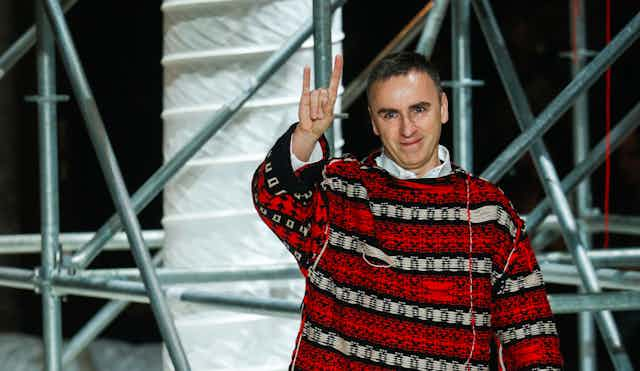Surviving 27 years in the competitive and fast-changing world of fashion is an accomplishment many brands only dream of. Raf Simons weathered the 2007-08 financial crisis, Brexit and the COVID pandemic with his eponymous label, but in November he announced that the SS23 line would be its last.
“Everything changes, both in our ideas and in the material world. Some changes happen gradually, but often the most important changes are not gradual but discontinuous or jerky.” So says Marxian theory (as articulated by sociologists Peter Knapp and Alan Spector) and, clearly, so says Raf Simons, who has timed the closure of his self-titled label perfectly.
Now the co-creative director of Prada, Simons has shut down his own label at just the right time to preserve his brand’s undeniable mark on the industry while also enabling him to expand his name and vision at a bigger house.
The timing couldn’t be better. In November, brand consultancy Interbrands rated Prada as one of the fastest growing and “best global brands 2022”, and valued it at USD$6.548 billion.
As an expert in fashion marketing, I believe that Simons’s decision reflects the reality of the industry. Many designers start out as owners of their own brands in order to expand their portfolio, but as their careers progress and they become involved with major houses they can no longer cope with the strains of maintaining two brands.
Catherine Hudson, associate lecturer in fashion design at the University of East London, expressed another point of view to me: “What Simons was once known for – bomber jackets, pop culture inspired themes, patchwork, loose fits – other designers are now grabbing onto. His brand has just not remained relevant enough.”
What was the Raf Simons line known for?
Journalist Nicole Johnson noted in recent musings on fashion legacy: “The most influential fashion brands and designers stand the test of time, having occupied distinctive places in fashion history. These icons enjoyed the unique experience of influencing generations.”
From the late Nineties, Raf Simons’ ability to reframe the relationship between pop culture, art and clothing set the tone in menswear for luxury, casual, deconstructed, fashionable clothing.
Simons challenged the system with nonconforming designs that spoke to the industry and his fans alike. His fall 2016 menswear collection, Nightmares and Dreams, for example, was a fragmented line of his 20 year archive, suggesting a reclamation of his time following his departure from Dior. Torn, oversized sweaters, down jackets and misaligned coats made the statement that season.
Following his dramatic exit from Calvin Klein, Simons’s fall winter 2019/2020 collection was fraught with messaging that cult followers revelled in decoding. As journalist Steve Salter observed in a retrospective for Vice, “Raf’s vision was darker, dirtier and more underground than anything we had seen before … the counterculture genius let his statement filled collection do the talking.”
Why was it time for Raf Simons to close?
For nearly three decades, Simons excited a youthful fanbase with his merging of luxury fashion, music and hype. That is the mark his brand will leave on fashion history.
Today’s youth culture, however, wants something different. Fashion fan bases of today marvel in the exclusivity of brands like Supreme, the subcultural power houses of Stussy and Off-White, marketing genius of Balmain and Balenciaga and innovation of metaverse fashion brands such as RTFKT. Established brands like Hugo Boss, meanwhile, are reaching new youth audiences by collaborating with Tik Tok celebrities such as Khaby Lame.

While brands like Tommy Hilfiger and Lacoste restructured to grapple with the fashion industry’s captivation with streetwear, Raf Simons lost sight of the current needs of youth culture. Not adapting to the changing demands of his fanbase kept his brand in the past, and the audience his collections once spoke to slowly dwindled.
Nonetheless, Raf Simons has left a legacy. Under his tenure, Prada looks set to continue his reputation as a pioneer, translating the art of countercultures into contemporary fashion. Far from an end to Raf Simons’s visions, closing his own line could be just the beginning.

